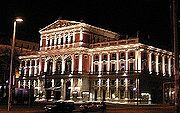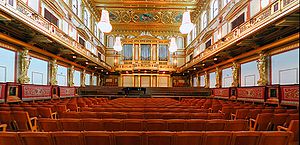
Musikverein, Vienna
Encyclopedia
Wiener Musikverein, (ˌviːnɐ̯ muˌziːkfɛʁˈʔaɪ̯n; "Viennese Music Association"), commonly shortened to The Musikverein, has a twofold meaning: it is the name of a famous Vienna
concert hall, as well as the short name for the music society, Gesellschaft der Musikfreunde
[Society of Music Friends], that owns the building.
This building is located on Dumbastraße behind the Imperial Hotel, between Bösendorferstraße and Karlsplatz
. However, because Bösendorferstraße is so small a street, the building is better known as being between Karlsplatz and Kärntner Ring (part of Ringstraße
loop). The back of the building faces Canovagasse [Canova lane].
The concert hall was built by the Gesellschaft der Musikfreunde, on a piece of land given by Emperor Franz Joseph
, and it was opened on January 6, 1870. A historic organ
was installed in it by the Austria
n firm Rieger
, in 1907. The Musikverein is famous for its acoustics
and is considered to be one of the five finest concert/opera venues in the world. None of these halls was built in the modern era with the application of acoustics science, and, with the partial exception of the horseshoe-shaped Colon, all share a long, tall, and narrow shape. It is the home to the Vienna Philharmonic.

 The Große Musikvereinssaal, or Goldene Saal (Golden Hall), is forty-eight metres long, nineteen metres wide, and eighteen metres high. It has 1,744 seats and standing room for 300. Every year, the Vienna New Year's Concert
The Große Musikvereinssaal, or Goldene Saal (Golden Hall), is forty-eight metres long, nineteen metres wide, and eighteen metres high. It has 1,744 seats and standing room for 300. Every year, the Vienna New Year's Concert
is held here.
Since 2001, the building has been undergoing renovation, and several new rehearsal and concert halls have been installed.
Vienna
Vienna is the capital and largest city of the Republic of Austria and one of the nine states of Austria. Vienna is Austria's primary city, with a population of about 1.723 million , and is by far the largest city in Austria, as well as its cultural, economic, and political centre...
concert hall, as well as the short name for the music society, Gesellschaft der Musikfreunde
Gesellschaft der Musikfreunde
The Gesellschaft der Musikfreunde in Wien , was founded in 1812 by Joseph von Sonnleithner, general secretary of the Court Theatre, Vienna, Austria. Its official charter, drafted in 1814, states that the purpose of the Society was to promote music in all its facets...
[Society of Music Friends], that owns the building.
This building is located on Dumbastraße behind the Imperial Hotel, between Bösendorferstraße and Karlsplatz
Karlsplatz
Karlsplatz is a town square on the border of the first and fourth districts of Vienna. It is one of the most frequented and best connected transportation hubs in Vienna. The Karlskirche is located here....
. However, because Bösendorferstraße is so small a street, the building is better known as being between Karlsplatz and Kärntner Ring (part of Ringstraße
Ringstraße
The Ringstraße is a circular road surrounding the Innere Stadt district of Vienna, Austria and is one of its main sights...
loop). The back of the building faces Canovagasse [Canova lane].
The concert hall was built by the Gesellschaft der Musikfreunde, on a piece of land given by Emperor Franz Joseph
Franz Joseph I of Austria
Franz Joseph I or Francis Joseph I was Emperor of Austria, King of Bohemia, King of Croatia, Apostolic King of Hungary, King of Galicia and Lodomeria and Grand Duke of Cracow from 1848 until his death in 1916.In the December of 1848, Emperor Ferdinand I of Austria abdicated the throne as part of...
, and it was opened on January 6, 1870. A historic organ
Pipe organ
The pipe organ is a musical instrument that produces sound by driving pressurized air through pipes selected via a keyboard. Because each organ pipe produces a single pitch, the pipes are provided in sets called ranks, each of which has a common timbre and volume throughout the keyboard compass...
was installed in it by the Austria
Austria
Austria , officially the Republic of Austria , is a landlocked country of roughly 8.4 million people in Central Europe. It is bordered by the Czech Republic and Germany to the north, Slovakia and Hungary to the east, Slovenia and Italy to the south, and Switzerland and Liechtenstein to the...
n firm Rieger
Rieger Orgelbau
Rieger Orgelbau is an Austrian firm of organ builders, known generally as Rieger. The firm was founded by Franz Rieger. From 1873 it was known as Rieger & Söhne, and from 1879 as Gebrüder Rieger, after his sons took over. At the end of World War II, the firm was nationalised by the Czech government...
, in 1907. The Musikverein is famous for its acoustics
Architectural acoustics
Architectural acoustics is the science of noise control within buildings. The first application of architectural acoustics was in the design of opera houses and then concert halls. More widely, noise suppression is critical in the design of multi-unit dwellings and business premises that generate...
and is considered to be one of the five finest concert/opera venues in the world. None of these halls was built in the modern era with the application of acoustics science, and, with the partial exception of the horseshoe-shaped Colon, all share a long, tall, and narrow shape. It is the home to the Vienna Philharmonic.


Vienna New Year's Concert
The New Year's Concert of the Vienna Philharmonic is a concert of classical music that takes place each year in the morning of January 1 in Vienna, Austria...
is held here.
Conductors
- 1933 Kurt AdlerKurt AdlerKurt Adler was an Austrian classical music conductor, chorus master and pianist with a European musical education. He was best known as the chorus master and conductor of the Metropolitan Opera in New York City from 1943 to 1973...
Since 2001, the building has been undergoing renovation, and several new rehearsal and concert halls have been installed.
| Concert Hall | Size | Height | Seats |
| Großer Musikvereinssaal (Goldener Saal) | 48,8 x 19,1 m | 17,75 m | 1744 seats and ca. 300 for standing |
| Brahmssaal | 32,5 x 10,3 m | 11 m | 600 seats |
| Gläserner Saal/Magna Auditorium | 22 x 12,5 m | 8 m | 380 seats |
| Metallener Saal | 10,5 x 10,8 m | 3,2 m | 70 seats |
| Steinerner Saal/Host Haschek Auditorium | 13 x ~8,6 m | ~3,3m | 60 seats |

